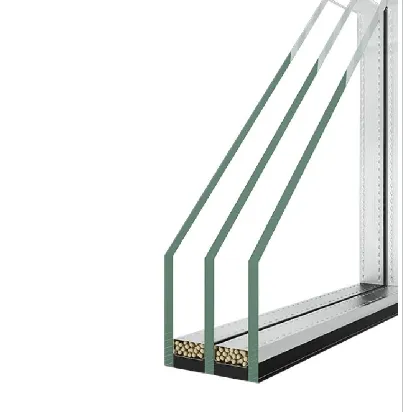

In the realm of sustainable architecture, low emissivity glass (low e glass) has emerged as a cornerstone of energy-saving design, seamlessly blending thermal efficiency with aesthetic versatility. From low e tinted glass that balances light and privacy to low e toughened glass combining durability with performance, and the cost-effective low e value glass, each variant addresses unique building needs. Understanding the science behind low emissivity glass coating reveals how this technology transforms ordinary windows into powerful energy barriers, revolutionizing modern construction.

Low E Tinted Glass marries the solar control of tinted panes with the thermal insulation of low e coatings, making it ideal for regions with intense sunlight. The tint—ranging from subtle gray to bronze—reduces glare and blocks up to 70% of solar heat, while the low e layer reflects interior heat back into the space. In Miami high-rises, low e tinted glass maintains 60% visible light transmittance (VLT) while achieving a solar heat gain coefficient (SHGC) as low as 0.25, preventing overheating without sacrificing views. For residential homes, this glass minimizes UV damage to furniture while cutting air-conditioning costs by up to 35%. The tinted low e coating is applied via sputtering, embedding nano-scale metal oxides that absorb infrared radiation while preserving clarity, unlike traditional dyed tints that darken glass excessively.
Low E Toughened Glass (tempered low e glass) combines the energy efficiency of low e coatings with the impact resistance of tempered glass, essential for safety-critical installations. The toughening process—heating glass to 620°C and rapid cooling—enhances strength fourfold, ensuring it shatters into harmless micro-pieces if broken. In commercial facades, low e toughened glass withstands high winds and thermal stress, while in residential balconies, it provides both safety and thermal insulation. For example, a Chicago office building using low e toughened glass in curtain walls can meet LEED certification requirements, reducing heating costs by 25% while complying with safety codes. The low e coating on toughened glass is applied post-tempering via durable pyrolytic processes or embedded in double glazing for maximum efficiency.
Low E Value Glass offers a balance of performance and affordability, making energy-efficient glazing accessible for residential renovations and small commercial projects. This glass typically uses hard-coat low e technology—applied at high temperatures during manufacturing—to create a durable, cost-effective coating. While less efficient than soft-coat variants (U-factor ~0.35 vs. 0.20), low e value glass still reduces heat transfer by 40% compared to standard glass, saving homeowners in temperate climates up to $200 annually on energy bills. In DIY renovations, replacing single-pane windows with low e value glass double glazings can eliminate drafts and condensation, while in retail spaces, it meets basic energy codes without exceeding budget. The hard coat’s durability allows for easier handling and cutting, ideal for on-site modifications.
Low Emissivity Glass (low e glass) owes its efficiency to a thin, invisible coating that regulates infrared light transfer. The coating—composed of silver, metal oxides, or nano-ceramics—has an emissivity (ε) as low as 0.02 (standard glass ε=0.84), reflecting 98% of thermal radiation. In winter, this keeps heat inside; in summer, it blocks solar heat. Modern low emissivity glass uses multi-layer sputtering to deposit coatings only 0.1–0.5 microns thick, thinner than a human hair. For example, a Seattle home with low emissivity glass in north-facing windows can maintain natural light while reducing heat loss by 70%, proving that efficiency doesn’t require sacrificing views. The technology adapts to climate: northern regions prioritize high visible light transmittance (VLT >70%) for daylight, while southern areas optimize for low SHGC (<0.30).
Low Emissivity Glass Coating is the technological heart of energy-efficient glazing, with variations designed for specific performance needs. Soft-coat coatings, applied via vacuum sputtering, feature ultra-thin silver layers that achieve the highest efficiency but require encapsulation in double glazing. Hard-coat coatings, applied at high temperatures, are more durable but less efficient, suitable for single-pane applications. Advanced coatings like low e + solar control integrate tinting with low e layers, while self-cleaning coatings combine photocatalytic titanium dioxide with low e technology. For example, a Tokyo skyscraper using low emissivity glass coating with photocatalysis can reduce maintenance costs by 50%, as the coating breaks down dirt under sunlight. The evolution of these coatings—from single-layer silver to multi-layer nano-composites—has driven U-factors from 1.0 to below 0.15 over two decades.
Low E Tinted Glass balances light and heat:
Yes, low e toughened glass is ideal for outdoor railings:
By harnessing the power of low e tinted glass, toughened glass, value glass, and the science of low emissivity glass coating, architects and homeowners can create spaces that are energy-efficient, safe, and visually stunning. Whether prioritizing budget, durability, or premium performance, low e technology offers a tailored solution for every building need, proving that sustainable design doesn’t compromise on style or functionality.